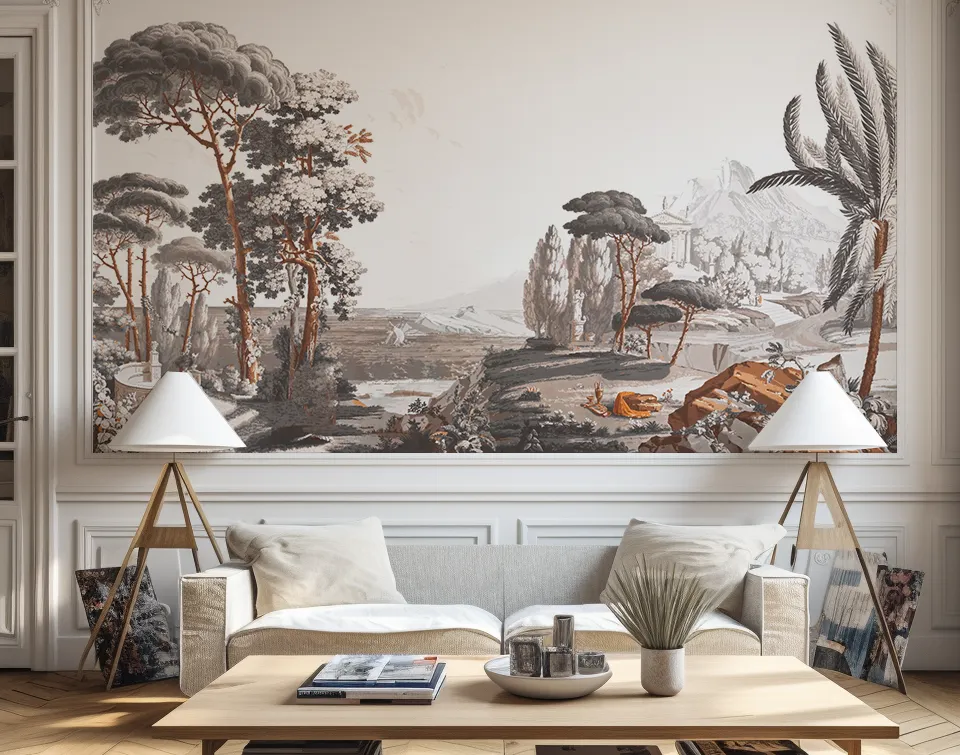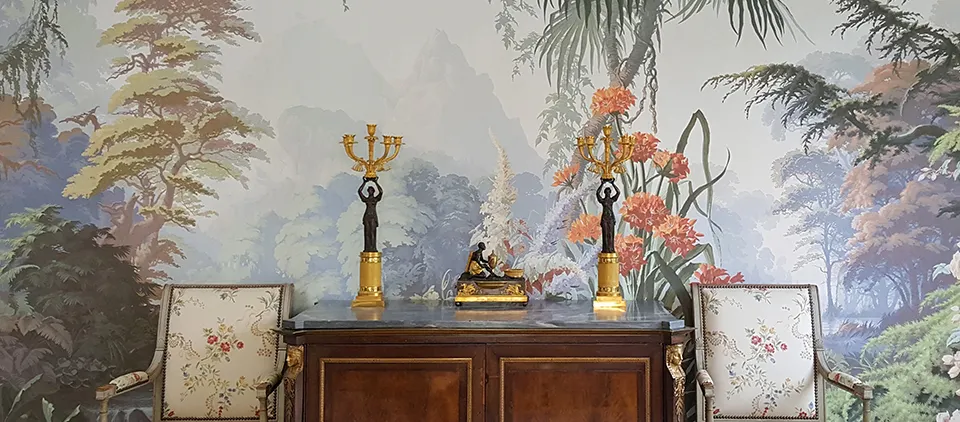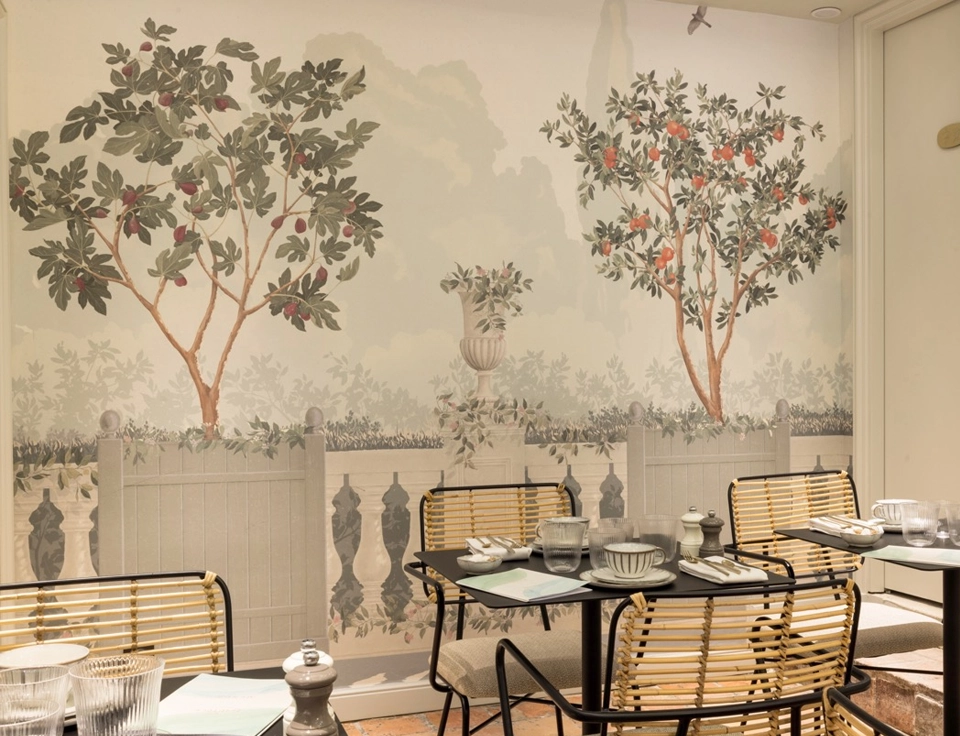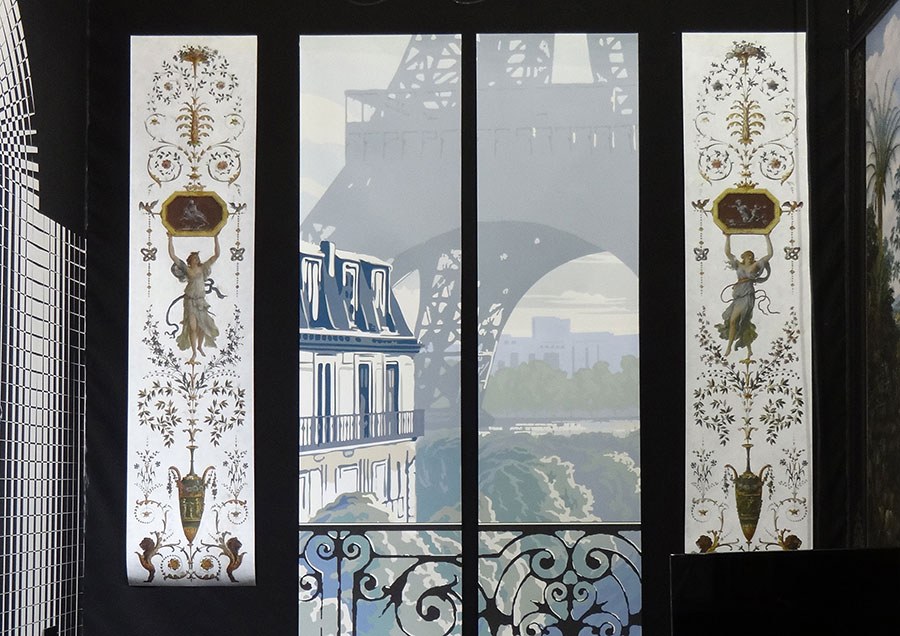Colors and patterns that visually enlarge
Opt for light hues and neutral shades
Light tones such as beige, white and verdigris encourage light to bounce back and give a feeling of spaciousness. They are particularly suited to dark or small rooms. Neutral shades - such as gray, taupe or blue - are recommended, as they create a soft, harmonious atmosphere in the room. It is advisable to avoid over-saturated or dark colors, which can visually diminish the space or create an oppressive atmosphere.
.
Prefer small and medium-sized patterns to avoid a constraining effect
.
The size and type of pattern on wallpaper also influence the perception of space. Small- to medium-sized patterns, such as polka dots, **flowers** or geometric shapes, are preferable to overly imposing or busy patterns, which can weigh down the room or make it feel cluttered. Patterns that are repetitive or repetitive can encourage a perception of the wall surface as being out of alignment, thus contributing to the visual enlargement of the room.
It's a good idea to keep a close eye on the design.
Conversely, patterns that are too irregular or high in contrast can break up visual continuity and reduce the sense of space.
The impact of cool colors on the overall look of a room can be considerable. The impact of cool colors on the perception of space
Cool colors, such as blue, green or violet, have this unique ability to give an impression of depth and remoteness. It is this type of color that is used in atmospheric perspective to simulate distance. They are therefore ideal for creating a sense of enlargement in a room.
These shades can be used on their own or combined with warmer hues, such as yellow, orange or red, to create a dynamic contrast. Cool colors are particularly suited to south-facing spaces, bringing freshness and tranquillity.
|
 |
Installation techniques to maximize space
Choosing the right color and pattern for your wallpaper is crucial, but the way you hang it can also transform your perception of space. Certain arrangements can visually enlarge your room. Here are a few tips:
The rôle of vertical lines to « push walls » upwards
Opting for vertical lines on your wallpaper creates the illusion of a higher ceiling. These lines direct the eye upwards, increasing the sensation of vertical space.
Choose a vertical stripe wallpaper, a classic and timeless choice, or vertical patterns such as chevrons or diamonds. This type of pattern is perfect for rooms with low ceilings or attic spaces.
Use panoramic wallpapers for enhanced depth
The panoramic wallpapers, with their representations of landscapes, cities, monuments or varied scenes, offer a sense of depth and space. This type of wallpaper is perfect for enlarging a room, including in professional contexts such as hotel wallpaper, where ambience and aesthetics are essential for the comfort of customers.
These wallpapers can be applied to the wall at the back of the room to create a focal point and simulate a visual opening. This type of wallpaper is ideal for rooms that are narrow or have windows. Installation tips: one wall or all walls?
To avoid an overloaded effect, it's generally advisable not to cover all walls with wallpaper that's too bold or saturated. In this case, it's a good idea to apply it to just one wall, leaving the other walls in plain or neutral tones to create a dynamic effect without weighing down the room.
Please note that the wallpaper can be applied to any wall.
If your choice is for a more discreet, light or uniform wallpaper, you might consider placing it on each wall, taking care to maintain visual harmony and avoid ruptures in style.
|
 |
|
Papier Peint Eden, versino Pastel - d'apres un original du MAD Paris
|
The trompe-l’œil and the art of illusion
Wallpaper isn't just a simple wall covering, it's a powerful tool capable of creating illusions of space and radically transforming a room. Different varieties of wallpaper can alter our perception of space and create unique, personalized atmospheres.
Wallpaper is a powerful tool for creating illusions of space and radically transforming a room.
Let's explore a few options:
Choosing trompe-l’œil panoramic wallpaper
Trompe-l'œil panoramic wallpaper reproduces 3D scenes or objects, such as a view of a window, a door, a library, or even a staircase, bringing depth and perspective. This type of wallpaper is perfect for an accent wall, ideally the one at the back of the room, to create a focal point and a feeling of space.
This option is particularly suited to rooms that lack character or windows.
This option is particularly suited to rooms that lack character or windows.
Rely on matières effects for unexpected relief
Did you know that wallpaper can imitate wood, stone, metal or leather to perfection? This trick not only creates a palpable textural effect, but can also give the illusion of a larger space. Apply this type of wallpaper to a speci;c wall or to all the walls, depending on the desired ambience.
Wallpaper can be applied to a wall or to all the walls, depending on the desired ambience.
Wallpaper can be applied to a wall or to all the walls, depending on the desired ambience.
Perfect for warming up rooms that seem too impersonal or cold.
The strategic use of wallpaper with geometric patterns to alter spatial perception.
Geometric patterns, such as diamonds, triangles or hexagons, can transform the perception of a room. They introduce movement and dynamism, creating a sense of spaciousness. This type of wallpaper is ideal for energizing a space, using it on a single wall or on all the walls by playing on color and contrast effects.
Idéal to revitalize spaces deemed too uniform or static.
|
 |
|
Wallpaper 'Trees and Balcony' - création Papiers de Paris
|
Conclusion
As you can see, the choice of wallpaper plays a crucial role in interior decoration, offering a unique opportunity to visually expand your spaces. By carefully selecting colors, patterns and installation techniques, wallpaper becomes a powerful tool for creating perspective, intensifying luminosity, adding contrast and relief, and even creating the illusion of a larger space. Wallpaper is also perfect for personalizing your space, allowing you to express your personal tastes and design unique atmospheres.
So don't delay, set out to find the wallpaper that will transform your room! Explore our vast selection of french wallpapers on our site and let us inspire you for your next decorating project. We wish you a pleasant exploration!
|
FAQ
How do you enlarge a small room with wallpaper?
To create the illusion of a larger room with wallpaper, opt for light colors, fine textures, regular or geometric patterns, vertical or horizontal stripes, and panoramic or trompe-l'oeil designs. These choices help create an enhanced sense of space, offering the illusion of depth, height, width or openness, tailored to your needs.
Which wallpaper gives height?
A vertical stripe wallpaper is ideal for visually increasing the height of a room, highlighting the ceiling and giving an impression of openness. Avoid overly large or dark patterns, which have the opposite effect. Panoramic striped wallpapers are perfect for maximum impact.
What colors enlarge a room?
Light, pastel hues, such as white, beige, linen, light blue, and soft yellow, visually enlarge a space because they reflect light better. You can also play with contrasts, painting a wall in a darker color or adding a base to create an interesting optical effect that seems to push the walls back.
Which wallpaper to enlarge a dining room?
To make a dining room appear larger, opt for light-colored wallpaper such as white, beige or gray. These maximize light reflection and the effect of space. Horizontal stripes or panoramic designs are also excellent for generating a broad perception of the room.
|
About the author
Jean-Baptiste Denis

Trained engineer and draftsman, passionate about art history and ornamentation in architecture and decoration.
Founder of Papiers de Paris
|
v |

